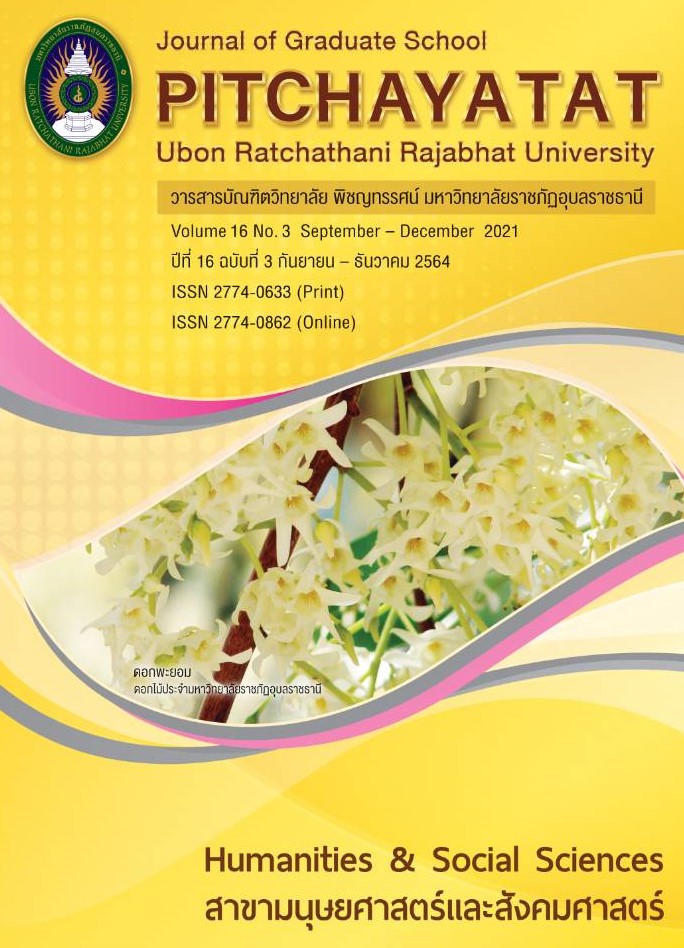การพัฒนารูปแบบการประเมินผลตามสภาพจริง อิงสมรรถนะในรายวิชาโครงงานตามหลักสูตรประกาศนียบัตรวิชาชีพ (ปวช.) วิทยาลัยเกษตรและเทคโนโลยีศรีสะเกษ
คำสำคัญ:
การพัฒนารูปแบบ, การประเมินผลตามสภาพจริง, รายวิชาโครงงานบทคัดย่อ
การวิจัยนี้มีวัตถุประสงค์เพื่อ 1) ศึกษาสภาพการประเมินผลตามสภาพจริง อิงสมรรถนะ 2) สร้างรูปแบบการประเมินผลตามสภาพจริง อิงสมรรถนะ 3) ทดลองใช้รูปแบบการเมินตามสภาพจริงอิงสมรรถนะ และ 4) ประเมินรูปแบบการประเมินตามสภาพจริงอิงสมรรถนะ เป็นการวิจัยเชิงคุณภาพ ซึ่งมีขั้นตอนการวิจัย ขั้นตอนที่ 1 ศึกษาสภาพรูปแบบการประเมิน กลุ่มเป้าหมาย ได้แก่ นักเรียนของโครงการอาชีวศึกษาเพื่อการพัฒนาชนบท (อศ.กช.) วิทยาลัยเกษตรและเทคโนโลยีศรีสะเกษจำนวน 10 คน โดยแบ่งตามกลุ่มอาชีพ ขั้นตอนที่ 2 เพื่อสร้างรูปแบบการประเมิน กลุ่มเป้าหมาย ได้แก่ ผู้เชี่ยวชาญ จำนวน 7 คน ขั้นตอนที่ 3 เพื่อทดลองใช้รูปแบบและประเมินรูปแบบใช้ กลุ่มเป้าหมาย ได้แก่ นักเรียนที่ลงทะเบียนเรียน สาขาวิชาเกษตรศาสตร์วิทยาลัยเกษตรและเทคโนโลยีศรีสะเกษ จำนวน 30 คน เครื่องมือที่ใช้ ได้แก่ แบบสังเกต แบบสัมภาษณ์ แบบสอบถาม สถิติที่ใช้ ได้แก่ ค่าเฉลี่ย และส่วนเบี่ยงเบนมาตรฐาน
ผลการวิจัยพบว่า
- สภาพการประเมินผลตามสภาพจริงได้แก่ ประเด็นที่ 1 การพัฒนารูปแบบการประเมินตามสภาพจริงอิงสมรรถนะ ได้แก่ 5 องค์ประกอบ ได้แก่ 1) ด้านผู้สอน 2) ด้านผู้เรียน 3) ด้านสภาพแวดล้อม 4) สื่อการเรียนรู้ 5) สภาพแวดล้อมในการเรียนรู้ (นอกห้องเรียน) ประเด็นที่ 2 กระบวนการพัฒนารูปแบบการประเมินผลตามสภาพจริง ได้แก่ 6 องค์ประกอบ ได้แก่ 1) การกำหนดสมรรถนะการเรียนรู้ 2) หลักสูตรการออกแบบการจัดการเรียนรู้ 3) การจัดแผนการเรียนรู้ตามรูปแบบการประเมินตามสภาพจริง 4) การเตรียมผู้สอน 5) การจัดการเรียนรู้โดยยึดกลุ่มอาชีพผู้เรียนเป็นฐาน 6) การพัฒนาผู้เรียนกิจกรรมการเรียนรู้พฤติกรรม
- การสร้างรูปแบบการประเมินตามสภาพอิงสมรรถนะ กำหนดปัญหาและการแก้ปัญหารูปแบบ การประเมินผลตามสภาพจริง ซึ่งประกอบด้วย 3 ด้านคือ 1) ข้อมูลพื้นฐานส่วนเกี่ยวข้อง 2) ความคิดเห็นแนวทางการจัดรูปแบบการประเมินผลตามสภาพจริงอิงสมรรถนะในรายวิชาโครงงาน มี 5 ด้าน และ 3) ความคิดเห็นต่อรูปแบบการประเมินผลตามสภาพจริงอิงสมรรถนะในรายวิชาโครงงาน มี 6 ด้าน ที่ต้องการพัฒนา
- ผลการทดลองรูปแบบการประเมินตามสภาพอิงสมรรถนะ ตามหลักสูตรประกาศนียบัตรวิชาชีพ (ปวช.) วิทยาลัยเกษตรและเทคโนโลยีศรีสะเกษประกอบไปด้วย 1) ศึกษาการสังเคราะห์ฐานอาชีพ 2) การพัฒนาการเรียนรู้ 3) การสร้างสมรรถนะการจัดการเรียนรู้ 4) เตรียมการผู้สอน 5) ปฏิบัติการเรียนรู้โดยยึดอาชีพเป็นฐาน
- ผลการประเมินรูปแบบการประเมินผลตามสภาพจริงอิงสมรรถนะ ในรายวิชาโครงงาน โดยรวม อยู่ในระดับมาก ( =4.49, S= .41)
เอกสารอ้างอิง
กฤษปกรณ์ สาคร และคณะ. “รูปแบบการพัฒนาสมรรถนะด้านการวัดและประเมินผลการศึกษาโดยใช้กระบวนการจัดการความรู้สำหรับครูโรงเรียนขนาดเล็ก,” วิชาการและวิจัยสังคมศาสตร์. 9, 26 (พฤษภาคม – สิงหาคม 2557): 29-42
คณะกรรมการการศึกษาแห่งชาติ, สำนักงาน. พระราชบัญญัติการศึกษาแห่งชาติ พ.ศ. 2542 และที่แก้ไขเพิ่มเติม (ฉบับที่ 2) พ.ศ. 2545. กรุงเทพฯ: พริกหวานกราฟฟิค, 2545.
วิชัย วงค์ใหญ่ และมารุต พัฒพล. กระบวนทัศน์ การโค้ชเพื่อเสริมสร้างทักษะการสร้างสรรค์และนวัตกรรม. กรุงเทพฯ: จรัลสนิทวงศ์การพิมพ์, 2558.
วิชัย วงค์ใหญ่ และมารุต พัฒพล. การประเมินตามสภาพจริงอิงสมรรถนะ. กรุงเทพ: ศูนย์ผู้นำนวัตกรรมหลักสูตรและการเรียนรู้, 2562.
สมศักดิ์ ภู่วิภาดาวรรธน์. การยึดผู้เรียนเป็นศูนย์กลางและการประเมินตามสภาพจริง. เชียงใหม่: เชียงใหม่แสงศิลป์, 2544.
Caslillo, J.G.D. et al. “Digital communication teachologies for teacher of science and mathematics in Mexico,” Journal of Instructional Pedagogies. 14 (March 2014): 1-16.
Department for Education. “The Professional Standards Framework for teacher,” Journal of vocational education and Training. 2 (July 2012): 175-186.
Edwards, M. G. and G. M. Poppy. Environmental benefits of genetically modified crops. In: Environmental impact of genetically modified crops, Eds N. Ferry and A.M.R: Gatehouse, 2009.
Havenga, H.M. “Project-based learning in higher education: Exploring programming students’ development towards self-directedness,” Journal of Higher Education. 29, 3 (Number 2015): 135–157.
Ismail, N.M. “Investigation of Teaching Competencies to Enhance Students EFL Learning at Taif
University,” Internation Education Studies, 7, 11 (October 2014): 84
Puckett, M.B. and J.K Black, Authentic Assessment of the Young Child: Celebrating Development and Learning. New York: Macmillan College Publishing, 1994.
Timperley, H. et al. “Teacher Professional learning and Development,” Internaltional Academy of Education. (April 2009): 61-74.
ดาวน์โหลด
เผยแพร่แล้ว
รูปแบบการอ้างอิง
ฉบับ
ประเภทบทความ
สัญญาอนุญาต
ลิขสิทธิ์ (c) 2021 วารสารบัณฑิตวิทยาลัย พิชญทรรศน์ มหาวิทยาลัยราชภัฏอุบลราชธานี

อนุญาตภายใต้เงื่อนไข Creative Commons Attribution-NonCommercial-NoDerivatives 4.0 International License.
บทความทุกเรื่องได้รับการตรวจความถูกต้องทางวิชาการโดยผู้ทรงคุณวุฒิภายนอกอย่างน้อย 2 คน ความคิดเห็นในวารสารบัณฑิตวิทยาลัย พิชญทรรศน์ มหาวิทยาลัยราชภัฏอุบลราชธานี เป็นความคิดเห็นของผู้เขียนมิใช่ความคิดเห็นของผู้จัดทำ จึงมิใช่ ความรับผิดชอบของบัณฑิตวิทยาลัย มหาวิทยาลัยราชภัฏอุบลราชธานี และบทความในวารสารบัณฑิตวิทยาลัย พิชญทรรศน์ มหาวิทยาลัยราชภัฏอุบลราชธานี สงวนสิทธิ์ตามกฎหมายไทย การจะนำไปเผยแพร่ต้องได้รับอนุญาตเป็นลายลักษณ์อักษรจากกองบรรณาธิการ






